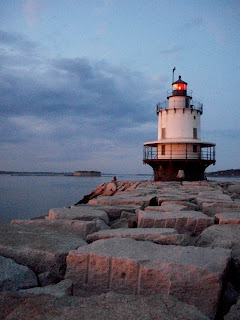Maine is a state for artists and Monhegan Island boasts an extraordinarily dense population of the rare, elusive and often cranky species. The light that glimmers and glints off the rocks that encircle this 1.75 mile wide island makes the place twinkle like stars in the daytime and the preserved wilderness areas that blanket the interior are gorgeous and can be seen via 17 miles of hiking trails.

Sunlight off island on the way to Monhegan
Mike was lucky enough to see extra stars as we were leaving the island when three middle aged women with glorious bosoms flashed the boat. Yes... it was a good day, for an artist. Monhegan has been a destination for us since we arrived in Portland and visited the Portland Museum of Art to view a Mainecenntric exhibition entitled, 'Call of the Coast: Art Colonies of New England'. Ever since Mike has had a glint in his eye to see the island on which the illustrious likes of Andrew, Jamie, and N.C. Wyeth have lived (Jamie is still a year round resident). Other notable residents include Edward Hopper (think Nighthawks), Winslow Homer and Rockwell Kent. Captain John Smith even stayed on the island for a time in 1614, but only long enough to ravage a native woman and bring death and enslavement to her community (just kidding, but probably true). Monhegan is accessible post-tourist season only by Monhegan Boat Line (est. 1914) out of Port Clyde Harbor which boasts a fleet of two handsome ships, the Laura B. (from WWII) and the Elizabeth Ann that function as supply and mail boats.

Gangway onto the Elizabeth Ann

Ready for a boat ride in a dorky hat!
One of these two boats is sent out to the island only three times a week and immediately turns around after unloading so if you aren't planning on staying at least two nights at one of the two B&B's open year-round you are out of luck. There are no cars or paved roads on the island either; the year round population hovers at around 65 enlightened souls, many with big boobs.

Old New England fish houses off an island on the way to Monhegan

Arrive at Monhegan

Are one of these a Wyeth house?

Island across from Monhegan with some sort of conveyor belt running up the side - for lobsters perhaps?
The name Monhegan derives from Monchiggon, Algonquian for "out-to-sea island" and it is fairly far from shore, a 50 min ride out and a 50 min ride back. We met two fine gentlemen from Ohio aboard ship, a strange coincidence because they were the only other people there simply for the boat ride. The two men were best friends and avid birders, one a biologist and the other, a manager for one of the departments of the Ohio State Historical Society. They knew the names of every bird we saw along the way and I have recorded them here faithfully:
Common Loon, Northern Ganet, Herring Gull, Great Black Backed Gull, Eider Duck, Phalaropes (a variety, can't remember the exact types), Shearwaters (ditto for them), Double Breasted and Great Cormorant, Raven, Black Guillemot, Common Murre (unconfirmed but possibly sighted), Dovekie
I was amazed at the huge array of bird life that was floating, skimming, diving and soaring below, on and above the dark blue Atlantic. It was a birders paradise and Mike and I were lucky to have been in the company of such expert birders, and from Ohio! More than anything, however, more than an artist colony, Monhegan, like most of coastal Maine pays homage to king lobster and clustered all around the island are fish and lobster houses used to process catches. We can't wait to come back during the spring and camp, hike and flash people!

Cool lobster boat close to Port Clyde

An army duck parked at Port Clyde Harbor

Marshall Point Lighthouse in Port Clyde, Mike painted it.

Plaque dedicated to fishermen who lost their lives while working

Sleepy Booth Bay Harbor, a sweet town on the way to Port Clyde

Saint George and the Dragon sculpture on Rte. 131














































